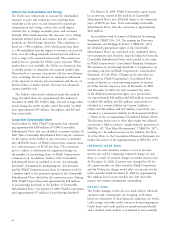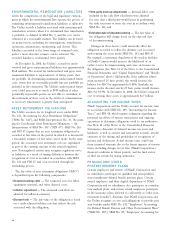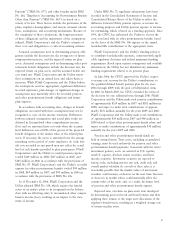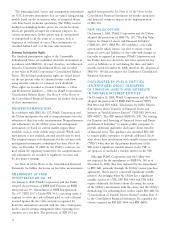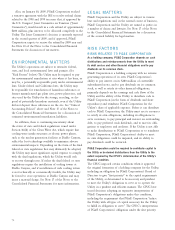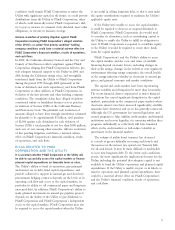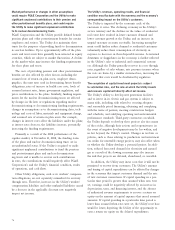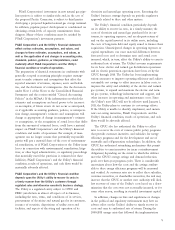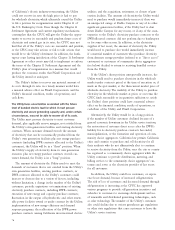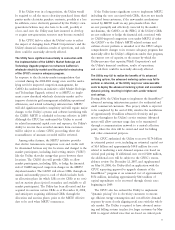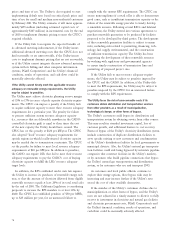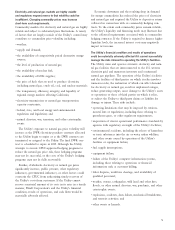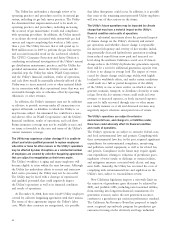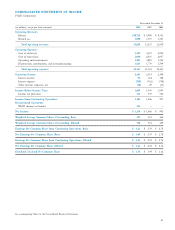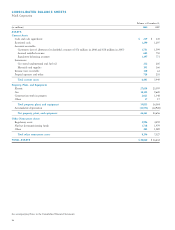PG&E 2008 Annual Report Download - page 76
Download and view the complete annual report
Please find page 76 of the 2008 PG&E annual report below. You can navigate through the pages in the report by either clicking on the pages listed below, or by using the keyword search tool below to find specific information within the annual report.74
The Utility’s revenues, operating results, and fi nancial
condition may fl uctuate with the economy and the economy’s
corresponding impact on the Utility’s customers.
The Utility is impacted by the economic cycle of the
customers it serves. The declining economy in the Utility’s
service territory and the declines in the values of residential
real estate have resulted in lower customer demand and
lower customer growth at the Utility, and an increase in
unpaid customer accounts receivable. Increasing unemploy-
ment could further reduce demand as residential customers
voluntarily reduce their consumption of electricity in
response to decreases in their disposable income. A sustained
downturn or sluggishness in the economy is further refl ected
in the Utility’s sales to industrial and commercial custom-
ers. Although the Utility generally recovers its costs through
rates, regardless of sales volume, rate pressures increase when
the costs are borne by a smaller customer base, increasing the
potential that costs would be disallowed by regulators.
The completion of capital investment projects is subject
to substantial risks, and the rate at which the Utility invests
and recovers capital will directly affect net income.
The Utility’s ability to develop new generation facilities
and to invest in its electric and gas systems is subject to
many risks, including risks related to securing adequate
and reasonably priced fi nancing, obtaining and complying
with the terms of permits, meeting construction budgets
and schedules, and satisfying operating and environmental
performance standards. Third-party contractors on which
the Utility depends to develop these projects also face many
of these risks, although their actions and responsiveness in
the event of negative developments may be less within, and
in fact beyond, the Utility’s control. Changes in tax laws or
policies, such as those relating to production and investment
tax credits for renewable energy projects, may also affect when
or whether the Utility develops a potential project. In addi-
tion, reduced forecasted demand for electricity and natural
gas as a result of the slowing economy may also increase
the risk that projects are deferred, abandoned, or cancelled.
In addition, the Utility may incur costs that it will not be
permitted to recover from customers. The Utility’s amount
and timing of capital expenditures can be affected by changes
in the economy that impact customer demand and the rate
of new customer connections. If capital spending in a par-
ticular time period is greater than assumed when rates were
set, earnings could be negatively affected by an increase in
depreciation, taxes, and fi nancing interest, and the absence
of authorized revenue requirements to recover a return on
equity on the amount of capital expenses that exceed assumed
amounts. If capital spending in a particular time period is
lower than assumed when rates were set, the Utility’s rate base
would be lower, depriving the Utility of the opportunity to
earn a return on equity on the delayed expenditures.
Market performance or changes in other assumptions
could require PG&E Corporation and the Utility to make
signifi cant unplanned contributions to their pension and
other postretirement benefi ts plans, and could require
the Utility to make signifi cant unplanned contributions
to its nuclear decommissioning trusts.
PG&E Corporation and the Utility provide defi ned benefi t
pension plans and other postretirement benefi ts for certain
employees and retirees. The Utility also maintains three
trusts for the purposes of providing funds to decommission
its nuclear facilities. Up to approximately 60% of the plan
assets and trust assets have generally been invested in equity
securities, which are subject to market fl uctuation. A decline
in the market value may increase the funding requirements
for these plans and trusts.
The costs of providing pension and other post retirement
benefi ts are also affected by other factors, including the
assumed rate of return on plan assets, employee demo-
graphics, discount rates used in determining future benefi t
obligations, rates of increase in health care costs, levels of
assumed interest rates, future government regulation, and
prior contributions to the plans. Similarly, funding require-
ments for the nuclear decommissioning trusts are affected
by changes in the laws or regulations regarding nuclear
decommissioning or decommissioning funding requirements,
changes in assumptions as to decommissioning dates, tech-
nology and costs of labor, materials and equipment change,
and assumed rate of return on plan assets. For example,
changes in interest rates affect the liabilities under the plans;
as interest rates decrease, the liabilities increase, potentially
increasing the funding requirements.
Primarily as a result of the 2008 performance of the
equities market, at December 31, 2008, the funding status
of the plans and nuclear decommissioning trusts are in
an underfunded status. If the Utility is required to make
signifi cant unplanned contributions to fund the pension
and postretirement plans and nuclear decommission-
ing trusts and is unable to recover such contributions
in rates, the contributions would negatively affect PG&E
Corporation’s and the Utility’s fi nancial condition, results
of operations, and cash fl ows.
Other Utility obligations, such as its workers’ compensa-
tion obligations, are not separately earmarked for recovery
through rates. Therefore, increases in the Utility’s workers’
compensation liabilities and other unfunded liabilities caused
by a decrease in the applicable discount rate negatively
impact net income.


